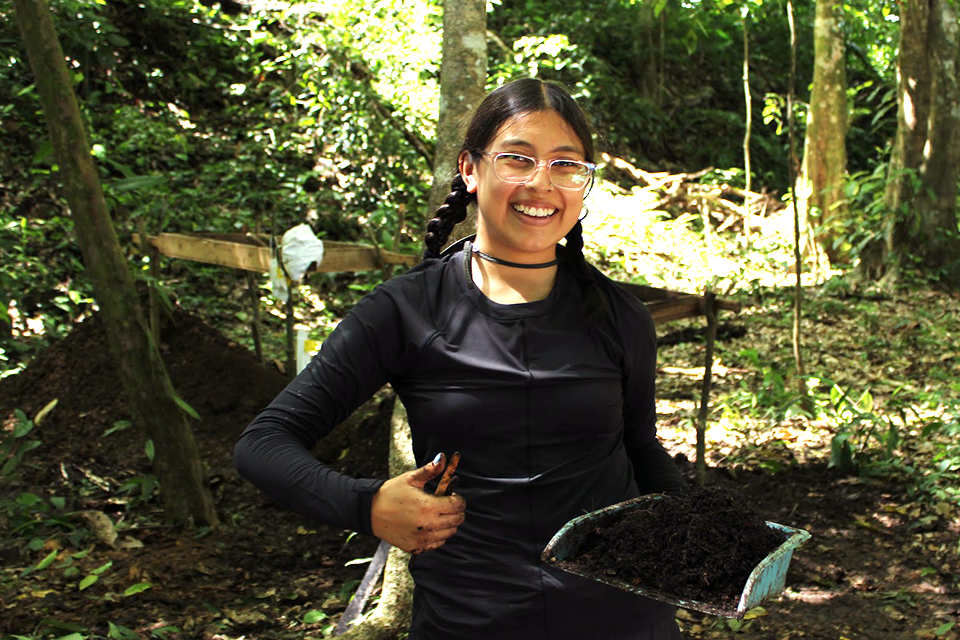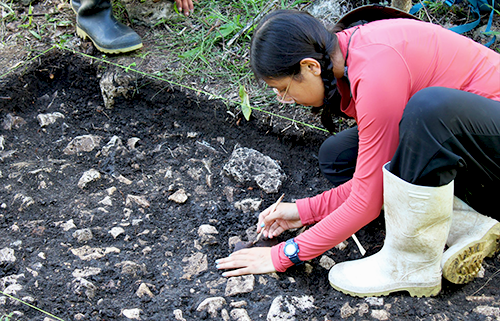Digging up history: Alex Bazarsky '23
“I now realize that I can do anything,” said Alex Bazarsky '23, reminiscing on her summer excavating in Mexico with professor Charles Golden.
 Photo/Alex Bazarsky
Photo/Alex BazarskyAlex Bazarsky '23 posing with her discoveries.
For many college students, an ideal trip to Mexico means kicking back on a beach, digging their toes in the sand. For Alex Bazarsky ’23, a double major in anthropology and Latin American studies with a minor in art history, it meant digging up history deep in a remote forest.
In the summer of 2020, Bazarsky participated in a virtual archeology internship under the mentorship of professor Charles Golden, developing skills in lidar, a remote sensor technology that can create a nearly complete picture of ruins otherwise hidden to the naked eye.
After two years of research, Golden asked Bazarsky to join his team in Chiapas, Mexico, excavating in-person. Her two summers of research were funded through the Provost's Summer Undergraduate Research Fellowship.
Bazarsky spent the summer digging with local Tzeltal community members, uncovering answers about the ancient Maya civilization that inhabited the area.
What was a typical ‘day in the life’ during this experience?
We started each day at 6:30 in the morning, having breakfast together at the ranch where we stayed, before heading to the field. We had a pretty long commute, driving an hour and a half to get there. We had to travel on foot from there, walking twenty minutes through two rivers and a forest.
Once we arrived, we excavated until 3:30 in the afternoon, pausing only to eat lunch with the community members we were working with, before driving back to the ranch. We spent the evening documenting our findings, cleaning ceramics we discovered, and having dinner together before wrapping up the day. We had a busy schedule, six days a week. The schedule just solidified how much I love this work.
You spent last summer conducting similar research, working with lidar. Was there a big difference in this experience?
Both experiences are very different, but each is important to the field of archeology. I prefer excavating because I love doing hands-on work. It’s one of the things that drew me to this field. I enjoy seeing materials come out of the ground that teach us more about the people and time periods we are studying. We develop a tangible idea of who these people really were.
I also feel extremely grateful for my skills in lidar. It is an amazing tool that allows us to study vast areas without things like shrubbery and forestry getting in the way. I will be putting the two experiences together for my senior thesis project.
Was there a language barrier?
I learned Spanish throughout high school, but only took one course my first year at Brandeis. As a result, I hadn’t spoken any Spanish in two years.
My roommate the first night, Fernanda - a student from Escuela Nacional de Antropología e Historia in Mexico City - spoke Spanish. I was nervous to communicate with her, but quickly found myself acclimating to conversations. I spent most of the first week listening, but was eventually able to socialize. By the end of the trip I could have longer and fuller conversations.
We always spoke Spanish, working with the community members in the field throughout the day. We also wrote all of our forms and journal entries in Spanish. I really enjoyed this experience and know I want to take more Spanish classes in the future to improve my skills.

Bazarsky spent most of her days excavating in the field, uncovering clay pieces and other small remnants.
What’s the excavation process like?
When people think of archeology, they usually imagine discovering burial tombs or large fossils. Archeologists do find these things, but our work was more focused on smaller day to day discoveries.
Most people also don’t realize how important community involvement is in this work. When researchers report findings, they sometimes fail to mention the entire community behind them in their discoveries. We worked with the Lacanja-Tzeltal community, who are part of an ancient Maya subgroup who have survived to the present day and are native to the central highlands of Chiapas, Mexico. They were in the field with us digging each day, but also taught us so much about their culture, language, way of living, and what community means to them. Their help was instrumental.
What are some of the things your group discovered?
Our first excavation site was a forested area near one of the arroyos, in a huge plaza with a pyramid in the corner. We found calcified snails and tool fragments, but mostly pieces of glazed and painted ceramic. Ceramics are unique because their thickness, color, and material illustrate what time period they came from.
Another important technique in archeology is observing the earth itself. During one of our digs we found a foundation of sand under a thick amount of clay-like dirt. We dug for a week, removing about three meters of sand. We found nothing physical, but discovered that the sand actually indicated waterfalls existed in the area for centuries.
With these findings, we determined the period of time the area was settled, because people could not have lived there until the waterfalls were gone. Findings like these are big stepping stones in learning about the history of these civilizations.
What was your biggest takeaway from this experience?
I now realize that I can do anything.
There were a lot of elements I had to overcome along the way, but once I started finally excavating, I knew that I was meant to be there — and I loved it.
I am so proud of all that I accomplished on this trip. I improved my Spanish, found interesting things, improved my archeology skills, and had an overall great experience that narrowed down my thesis plan. I’m ready now to look at graduate schools and pursue the future.
Categories: General, Humanities and Social Sciences, International Affairs, Research, Student Life





